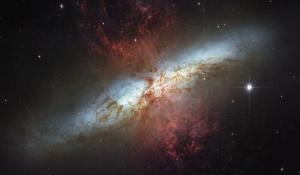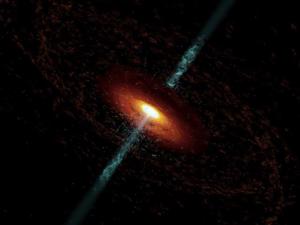Blog
Silencing the Stars
31 March 2022
 NASA, ESA and the Hubble Heritage Team (STScI/AURA)
NASA, ESA and the Hubble Heritage Team (STScI/AURA)One of the key aspects of galactic evolution is star production. On a basic level, stars form within a galaxy’s gas and dust all the time, and where they form can help determine a galaxy’s shape and size. But there seems to be a sweet point when star production in a galaxy is particularly strong. Galaxies often have a period of rapid star production which then drops off. Astronomers are still trying to understand what causes this drop-off.
One idea is that galaxies simply run out of the gas and dust needed to form stars. Stars consume gas and dust to form, and since stars can last for billions of years, there’s increasingly less material available. Another idea is that supernovae clear a galaxy of gas and dust. The earliest stars of a galaxy are often incredibly massive, living short lives and exploding as supernovae. The shock waves from these supernovae could quench star production by ripping apart star-forming regions. But a new study suggests the main cause is the supermassive black hole that lurks in the heart of a galaxy.1
In the study, the team took data from the Sloan Digital Sky Survey (SDSS) and applied machine learning to categorize galaxies into active galaxies where star formation is high and quiescent galaxies where star production is low. They then correlated these with three parameters: the mass of a galaxy’s dark matter halo, the total mass of stars in the galaxy, and the mass of the galaxy’s supermassive black hole. They found that black hole mass was the strongest factor in determining whether a galaxy is active or quiescent.
 Cosmovision, for A. Marscher; NRAO/AUI/NSF
Cosmovision, for A. Marscher; NRAO/AUI/NSFBut why would this be? To answer this question, the team used computer simulations to model various possibilities for quenching star production. By comparing their simulations with the observed distribution of galaxies, they found the strongest model was one where a supermassive black hole injects energy into the surrounding galaxy. As a galaxy’s black hole grows, it becomes an active galactic nucleus (AGN), which can create powerful jets and push gas and dust away from the center of the galaxy. The larger the black hole, the more powerful that push can be.
Galaxies with lots of gas and dust in their central region are ripe for star production. But they are also the perfect setting for supermassive black holes to grow larger. So, a galaxy can be active for a time, until the black hole becomes active itself and kills off star production.
Piotrowska, Joanna M., et al. “On the quenching of star formation in observed and simulated central galaxies: Evidence for the role of integrated AGN feedback.” Monthly Notices of the Royal Astronomical Society 512.1 (2022): 1052-1090. ↩︎